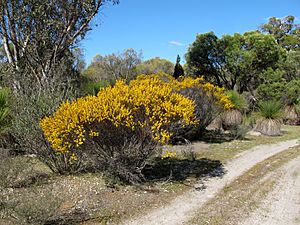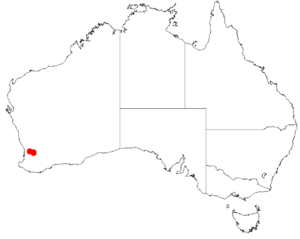Western Wheatbelt wattle facts for kids
Quick facts for kids Western Wheatbelt wattle |
|
|---|---|
 |
|
| Conservation status | |
| Scientific classification | |
| Genus: |
Acacia
|
| Species: |
brachypoda
|
 |
|
| Occurrence data from AVH | |
| Synonyms | |
|
Racosperma brachypodum (Maslin) Pedley |
|
The Acacia brachypoda, often called the Western Wheatbelt Wattle or Chinocup Wattle, is a special kind of Acacia plant. It's a shrub that only grows in a small part of western Australia's wheatbelt region. This plant is currently an endangered species, meaning it's at high risk of disappearing forever.
What Does It Look Like?
This wattle is a bushy plant that has a slight smell. It usually grows to be about 1 to 3 metres (3 to 10 ft) tall and 1 to 4 m (3 to 13 ft) wide. Its green leaves, which are actually flattened stems called phyllodes, stand up straight. They are smooth (which means they are glabrous) and can be round or flat with visible lines (nerves).
These phyllodes are about 2 to 5 cm (0.79 to 1.97 in) long and only 1 mm (0.039 in) wide. The plant blooms between May and July, showing off bright yellow flowers. These flowers are shaped like small balls and grow in pairs where the leaves meet the stem (this spot is called a leaf axil). Each flower ball sits on a short stalk, about 2 to 3 mm (0.079 to 0.118 in) long.
After the flowers fade, the plant forms smooth, curved, or coiled seed pods. These pods are about 7 to 8 mm (0.28 to 0.31 in) wide. Inside, the seeds are about 4 mm (0.16 in) long and have a yellow-brown part called an aril, which helps with seed spread.
How Was It Named?
The Western Wheatbelt Wattle was first officially described by a botanist named Bruce Maslin in 1990. He wrote about it in a scientific journal called Nuytsia.
For a short time, in 2003, another botanist named Leslie Pedley changed its scientific name to Racosperma brachypodum. However, in 2006, it was moved back to its original group, the Acacia genus.
Where Does It Live?
This shrub is endemic to a small area in Western Australia, which means it naturally grows only there. You can find it between the towns of Beverley, Brookton, and York in the Wheatbelt region.
It likes damp, low-lying places like swamps, where it grows in sandy-clay or loam soils. There are only six known groups (populations) of this wattle left, with about 5,000 individual plants in total. One of these groups lives inside the Wandoo National Park, which helps protect it. The other groups are found along roadsides and in old railway areas.
The Western Wheatbelt Wattle often grows in open woodlands, forming a thick layer of plants under taller trees. It commonly grows near Eucalyptus wandoo trees or other plants like Allocasuarina species, Callistemon phoeniceum, Hakea varia, and different types of Leptospermum and Melaleuca.
Why Is It Endangered?
The Western Wheatbelt Wattle is considered an endangered species because there are so few of them left. It was officially listed as endangered in 2008 under a law called the Environment Protection and Biodiversity Conservation Act 1999. Before that, it was also listed as endangered under an older law from 1992.
In Western Australia, it's listed as "rare flora" under the Wildlife Conservation Act 1950. This means it's a special plant that needs protection. In 2012, the species was also added to the IUCN Red List, which is a worldwide list of threatened species. All these listings show how important it is to protect this unique Australian plant.


